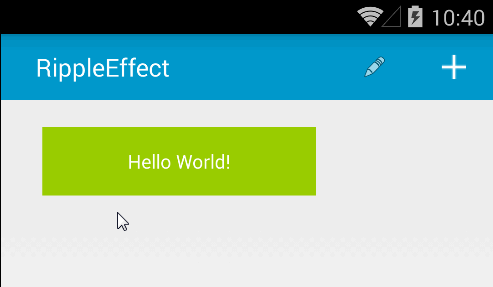CardView's background which will respond to android:state_selected and android:state_pressed
I\'m referring to the answer at https://stackoverflow.com/a/24475228/72437
The proposed answer is using drawable from Android : ?android:attr/selectableItemBac
-
I've just tried
MaterialCardViewand this works:<com.google.android.material.card.MaterialCardView android:id="@+id/material_card_view" android:layout_width="match_parent" android:layout_height="wrap_content" android:layout_margin="@dimen/activity_vertical_margin" app:cardCornerRadius="4dp" app:cardBackgroundColor="@color/selector_background_color" app:strokeWidth="2dp">selector_background_color.xml
<?xml version="1.0" encoding="utf-8"?> <selector xmlns:android="http://schemas.android.com/apk/res/android"> <item android:color="@android:color/white" android:state_activated="true"/> <item android:color="@android:color/darker_gray" android:state_activated="false"/>In the Activity/Fragment:
material_card_view.setOnClickListener { it.isActivated = !it.isActivated }For the
strokeColorthough, you can't use a selector. You will have to do it programmatically if you want the stroke color to change as per selector state.Example for state_activated:
val colorStateList: ColorStateList = ResourcesCompat.getColorStateList(resources, R.color.selector_stroke_color, null)!! val colorForState =colorStateList.getColorForState(intArrayOf(android.R.attr.state_activated), colorStateList.defaultColor) material_card_view.strokeColor = colorForState讨论(0) -
I believe you are misunderstanding the question you referred to. The question is how to get the ripple effect:

Where I think you are just looking for click feedback? If so, try setting the background drawable:
android:background="@drawable/statelist_item_background"EDIT:
On you background color xml, you need to give it an alpha. It is being drawn in the front, so give it an alpha of
.1fand see how that looks and go from there. Try using color50F76D3CThen use is it in the foreground like you were originally.讨论(0) -
for the background not covering the entire card issue, it is due to the cornerRadius drawing limitation. There are two solutions for this:
Disable round corner for your card will resolve the problem.
app:cardCornerRadius="0dp"You can retain cardCornerRadius but you need to set
app:cardPreventCornerOverlap="false"
讨论(0) -
After experimenting for quite some time, I can pretty much conclude that this is limitation of current
CardView- https://code.google.com/p/android/issues/detail?id=78198Don't use
CardView's foreground workaround. Although it is widely being proposed, it just don't work!My suggestion is, avoid using
CardViewif you need a customized selector. Replace itLayerDrawable. Here's what I had done.card.xml
<layer-list xmlns:android="http://schemas.android.com/apk/res/android"> <item> <shape> <padding android:top="1dp" android:right="1dp" android:bottom="1dp" android:left="1dp" /> <solid android:color="@android:color/transparent" /> <stroke android:width="1dp" android:color="#ffededed" /> <corners android:radius="2dp" /> </shape> </item> <item> <shape> <padding android:top="1dp" android:right="1dp" android:bottom="1dp" android:left="1dp" /> <stroke android:width="1dp" android:color="#ffe8e8e8" /> <corners android:radius="2dp" /> </shape> </item> <item> <shape> <padding android:top="0dp" android:right="1dp" android:bottom="1dp" android:left="1dp" /> <stroke android:width="1dp" android:color="#ffe1e1e1" /> <corners android:radius="2dp" /> </shape> </item> <item> <shape> <padding android:top="0dp" android:right="0dp" android:bottom="1dp" android:left="0dp" /> <stroke android:width="1dp" android:color="#ffdbdbdb" /> <corners android:radius="2dp" /> </shape> </item> <item> <shape> <padding android:top="0dp" android:right="0dp" android:bottom="1dp" android:left="0dp" /> <stroke android:width="1dp" android:color="#ffd5d5d5" /> <corners android:radius="2dp" /> </shape> </item> <!-- <item> <shape> <padding android:top="0dp" android:right="0dp" android:bottom="1dp" android:left="0dp" /> <stroke android:width="1dp" android:color="#ffcfcfcf" /> <corners android:radius="2dp" /> </shape> </item> --> <item> <shape > <solid android:color="#ffffffff" /> <corners android:radius="2dp" /> </shape> </item> </layer-list>card_selected.xml
<layer-list xmlns:android="http://schemas.android.com/apk/res/android"> <item> <shape> <padding android:top="1dp" android:right="1dp" android:bottom="1dp" android:left="1dp" /> <stroke android:width="1dp" android:color="#ffededed" /> <corners android:radius="2dp" /> </shape> </item> <item> <shape> <padding android:top="1dp" android:right="1dp" android:bottom="1dp" android:left="1dp" /> <stroke android:width="1dp" android:color="#ffe8e8e8" /> <corners android:radius="2dp" /> </shape> </item> <item> <shape> <padding android:top="0dp" android:right="1dp" android:bottom="1dp" android:left="1dp" /> <stroke android:width="1dp" android:color="#ffe1e1e1" /> <corners android:radius="2dp" /> </shape> </item> <item> <shape> <padding android:top="0dp" android:right="0dp" android:bottom="1dp" android:left="0dp" /> <stroke android:width="1dp" android:color="#ffdbdbdb" /> <corners android:radius="2dp" /> </shape> </item> <item> <shape> <padding android:top="0dp" android:right="0dp" android:bottom="1dp" android:left="0dp" /> <stroke android:width="1dp" android:color="#ffd5d5d5" /> <corners android:radius="2dp" /> </shape> </item> <!-- <item> <shape> <padding android:top="0dp" android:right="0dp" android:bottom="1dp" android:left="0dp" /> <stroke android:width="1dp" android:color="#ffcfcfcf" /> <corners android:radius="2dp" /> </shape> </item> --> <item> <shape> <solid android:color="#ffffe1b3" /> <stroke android:width="1px" android:color="#fff76d3c" /> <corners android:radius="2dp" /> </shape> </item> </layer-list>statelist_item_background.xml
<?xml version="1.0" encoding="utf-8"?> <selector xmlns:android="http://schemas.android.com/apk/res/android" android:exitFadeDuration="@android:integer/config_mediumAnimTime"> <item android:state_pressed="true" android:drawable="@drawable/card_selected" /> <!-- pressed --> <item android:state_selected="true" android:drawable="@drawable/card_selected" /> <!-- pressed --> <item android:drawable="@drawable/card" /> </selector>layout.xml
<!-- A CardView that contains a TextView --> <LinearLayout xmlns:android="http://schemas.android.com/apk/res/android" xmlns:tools="http://schemas.android.com/tools" android:padding="10dp" android:layout_marginLeft="5dp" android:layout_marginRight="5dp" android:layout_marginTop="5dp" android:layout_marginBottom="5dp" android:background="@drawable/statelist_item_background" android:layout_width="match_parent" android:layout_height="match_parent" android:clickable="true" > <TextView android:id="@+id/txt_label_item" android:layout_width="wrap_content" android:layout_height="wrap_content" android:textAppearance="?android:attr/textAppearanceLarge" tools:text="Item Number One" /> <TextView android:id="@+id/txt_date_time" android:layout_width="wrap_content" android:layout_height="wrap_content" android:textAppearance="?android:attr/textAppearanceMedium" tools:text="Item Number One" /> </LinearLayout>You will get the pretty nice outcome.
讨论(0) -
All my card content (TextViews) are blocked. How can I avoid such?
Your blocked issue can easily be solved with some color theory knowledge. Instead of using the given peach color, you could use a variant of the peach shade with a higher transparency.
Color Code scheme in Android xxyyyyyy
xx is your transparency level, and y's are your color.
xx max value is : ff // this is fully visible
xx min value is : 00 // this is full invisible
So by playing around on the color wheel, you can get the right effect with the right amount of transparency needed for your view.
讨论(0)
- 热议问题

 加载中...
加载中...